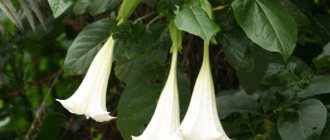Save our selection of the most common types and varieties of phlox in cultivation. We are sure that you will certainly find something for your garden in it!
Phlox are delightful flowers that amaze with a variety of shapes, sizes and shades. Among them there are bush and ground cover species, both spring and summer flowering. You can choose a variety with snow-white or variegated flowers. Whatever type or cultivar you choose, you can be sure of one thing - phlox will not disappoint you.
general description
The genus represents more than 80 species of perennial and annual plants of the Sinyukhov family (Polemoniaceae), 40 grow successfully in gardens. Some species bloom in spring, others in summer and autumn. The flowers can be light blue, purple, pink, bright red or white. Many of them are fragrant.
The plant is herbaceous (sometimes woody at the base) with straight shoots up to 120 cm high, less often with creeping shoots. Five-petalled flowers, crowded in the upper inflorescences (thyroid, paniculate), rarely solitary.
The upper part of the petals is rounded or with indentations, their roots are fused into a long and thin tube. The crown tube contains 5 stamens of unequal length and one pistil.
Phlox leaves serve as food for the larvae of some lepidopteran species, including butterflies. Some plant species are also a popular food source for groundhogs, rabbits and deer.
Description of species and varieties with photos
The genus Phlox includes more than 80 species of plants found naturally throughout North America. One of the species is found naturally in Siberia - Phlox sibirica.
Paniculate
The perennial plant paniculata (Phlox paniculata) is characterized by tough shoots up to 1.2 meters high. The panicles bloom in summer, the flowers are bright, which attracts many butterflies to the garden. The color of the petals varies depending on the variety, with purplish-violet or purplish-pink petals being typical. Completely frost-resistant.
Young plants for rocky gardens should be planted in the fall. The soil for growing should be fertile and moderately moist. With higher air humidity, flowering will be more abundant. The growing location should be sunny or slightly shaded, protected from the winds. Phlox should not be grown in marshy, clayey places, where they are susceptible to disease. It is worth mulching the soil around the plants with bark or peat to avoid the soil drying out too quickly.
It is important to take care of regular watering of flowers, especially during dry periods. Phlox develops quite quickly, so they need fertilizer. But they do not respond well to fertilizing with mineral fertilizers, so it is better to use organic ones.
It is better to replant paniculate varieties in the spring (March-May). In the spring, you can carry out anti-aging pruning and propagation by division. Before winter, shoots should be cut low to the ground.
There are about 200 cultivars of the Phlox paniculata species. Varieties differ in flower color, shoot height, and flowering period.
Blooming in early summer
Varieties of paniculate phlox that begin flowering in early summer:
- “Mike's Favorite” Mike's Favorite is the earliest flowering variety (flowering period: June-July), with white flower petals and a purple eye, shoots up to 40-50 cm long.
- “Peppermint Twist” Peppermint Twist is an interesting striped variety, blooms profusely all summer (from June to August), flowers with pink petals with white stripes, plant height – 50-70 cm, smells wonderful.
- "Prospero" Prospero is a dwarf striped variety (10 cm), characterized by light purple flowers with white stripes.
- "Europe" Europa - from June to September is decorated with flowers with a bright pink center and white petals with a conical base. Reaches 80 cm, belongs to medium-sized perennial plants.
- “Violet Charm” Violet Charm is a low, compact variety from the Flame series, characterized by compactness, reaching a height and bush diameter of 50 cm. Charming purple flowers appear from June to September. An additional decoration is the white eyes, which blur closer to the end of the petals.
Blooming from July to autumn
You can admire the flowers of the following varieties from the end of June to September-October:
- “Ural Tales” is synonymous with Ferris Wheel - the plant grows up to 80 cm, forming lush clusters of unbranched shoots. Fragrant, honey-bearing flowers appear from July to mid-September. Flowering is unusually abundant. The pink flowers with a dark eye in the center look fantastic against the background of green foliage. The petals curl charmingly into a ruffled shape and are adorned with dark pink veins. Low growing requirements.
- "Fujiyama" Fujiyama - growing to about 70-100 cm with snow-white flowers.
- “Gzhel” is a variety of paniculate phlox, which is popular because of the beautiful color of the flowers, reminiscent of Gzhel painting, combining tones - blue, lilac, light blue. The height can reach 0.8-1 meter, the circumference of the bush is 0.6-0.7 m.
- "Indian Summer" - grows to approximately 70-90 cm. Stiff, raised shoots with light green lanceolate leaves. From July to mid-September, lush, dense inflorescences appear. The edges of the delicate snow-white petals are decorated with creamy green inserts.
- “Delilah” Delilah is a compact variety of purple phlox with a purple tint, reaches 50-60 cm, width is approximately 30-45 cm. Violet-pink, densely collected flowers look beautiful against the background of green elongated leaves. Beautiful inflorescences decorate the garden from July to September and have a pleasant sweet aroma.
- “Twister” Twister is a variety with captivating two-color flowers, medium-sized (60 cm), forms spectacular clusters. Straight shoots along the entire length are covered with dark green pointed lanceolate leaves. Cute snow-white flowers, decorated with dark pink stripes running along the petals, form semicircular compact umbrellas at the tops of the shoots and look as if they were painted by hand with a brush. Inflorescences appear from July to August, captivating with their sweet aroma.
- “Larissa” Larrisa is a profusely flowering, medium-sized variety (85-90 cm), decorated with dazzling flowers of a beautiful pink color. Inflorescences with a captivating scent. Delicate pink petals, decorated with thin white accents, surround the small center of the flower, emphasized by the characteristic crimson eye.
- “Coral” Coral is a miniature dwarf variety of phlox from the “Flame” series, distinguished by the beautiful coral coloring of large inflorescences. Reaches small sizes (up to 30 cm). Creates bushy plants with lush inflorescences. Blooms for a long time, abundantly.
- "David" David is a plant with beautiful snow-white inflorescences and long lanceolate green leaves. Spectacular, dense bushes reach 70-80 cm. From July to September, the tops of the stems are decorated with white inflorescences with a charming sweet aroma. The flowers are very durable and you can create wonderful fragrant bouquets. The unusual decorative qualities of David phlox are recognized by the British Royal Horticultural Society and awarded the Garden Merit award.
- Variety of blue phlox "Blue Paradise" Blue Paradise. An interesting, fairly tall (80-100 cm) variety with blue flowers with a purple tint. Paniculate fragrant inflorescences appear from July to September. The color of the petals varies depending on the amount of light and air humidity. On a sunny afternoon, the inflorescences shimmer with shades of purple; in the morning and evening, when there is less sun, they acquire a wonderful rich blue tone.
- Another blue phlox, Younique Old Blue, grows to about 40 cm. From July to mid-September, beautiful round flowers appear, collected in dense clusters. Lilac-blue flowers with a large white center spread a light, pleasant aroma into the air.
- “Laura” Laura – color: pink-white, planting date in autumn: IX-XI. Flowering time: VII-VIII. Plant height – 80-110 cm.
- “Eva Foerster” Eva Foerster - the name of the variety comes from the wife of the famous garden designer and florist Karl Foerster. The plant pleases with pink-salmon flowers with a large white eye. Dense inflorescences are collected in apical scutes and fascinate with color from July to September. On summer evenings, the perennial spreads an intoxicating aroma, noticeable from a distance of several meters. They grow to about 80 cm, forming dense clusters.
- “Sherbet Blend” Sherbet Blend – distinguished by characteristic pink petals with a beautiful lemon edge. Average height - 0.8-1 meter. Blooms from July to September.
- "Jade" Jade is an elegant plant with white flowers with a lime-green edge. The colors combine so well that they create a subtle tone in perennial beds.
- "Spitfire" Spitfire is a beautiful variety with bright pink-orange flowers 3 cm in diameter with a dark pink eye and an intense aroma. Clusters of erect shoots 70-80 cm long.
- "Creme de la Creme" Creme de la Creme is a plant with two-color pink-cream flowers that rise gracefully at the tops of the stems.
- "Neon Flare" Neon Flare is a charming variety with white flowers with a pink-blue eye and the same edge of the petals. The plant blooms all summer.
- "Orange Perfection" Orange Perfection - distinguished by intense, bright orange inflorescences.
- “Count Zeppelin” Graf Zeppelin – phlox height – 50-100 cm, soft pink flowers with a contrasting eye. Frost resistance: -30 °C. Soil reaction: neutral.
- "Cleopatra" Cleopatra is a variety with lush, fragrant, heather-pink inflorescences. A reliably flowering perennial with a shoot height of 60-80 cm.
- “Flame Red” Flame Red is a beautiful dwarf variety of red phlox, growing to about 30-50 cm. Since July, it has been decorating the garden with wonderful flowers of rich red color with a hint of pink. The variety is characterized by abundant flowering and densely arranged inflorescences. The flowers exude a pleasant sweetish aroma, honey plant.
- "Flame Pink" Flame Pink - delights with fragrant pink flowers with dark pink eyes, collected in large dense inflorescences located on hard shoots. Reaches a small height: about 30-50 cm. Grows and blooms well in sunny places.
- "Flame Lilac" Flame Lilac - has numerous purple and white flowers. The length of the shoots is 40-50 cm. Planted at a distance of 20-30 cm. Frost-resistant variety.
Other varieties begin flowering in July and end in August:
- "Blue Boy" Blue Boy - blue flowers, fairly tall shoots (70-100 cm).
- “Bright Ice” Bright Eyes is a variety with abundant flowering and large inflorescences, 50-90 cm in height. Forms compact bouquets with straight shoots, light pink flowers decorated with carmine pink eyes located in the center of each flower on the inflorescence.
- “Younique Orange” Younique Orange is another variety of orange phlox, compact, blooms profusely from July to September. Bright coral-orange petals adorn the characteristic pink-red eye. The length of the stems is 40-50 cm and the diameter of the bushes is the same.
- "Early Purple Eye" Early Purple Eye is a miniature, early-blooming purple phlox with a white eye. Recommended for sunny, ventilated locations with moderately moist soil. Compared to other phlox, it is resistant to mildew, but still avoid getting the leaves wet when watering. Frost-resistant, long-flowering plant, reaching 40 cm. Flowering months: VII-VIII.
- "Starfire" Starfire - intense red flowers, shoot height - 0.7-1 meter.
- "Erli Cerise" Early Cerise is a low variety (25-30 cm), compact, with an earlier flowering period. The leaves are long, lanceolate, green. Flowers (July-August) are fuchsia pink, forming a large ball located at the tops of hard leafy shoots.
Late
Late varieties of paniculate phlox bloom:
- in the middle and end of August (“Cecile Henbury”, “Ivan-Zarya”, “Lilak Time”, “New”, “Late Foster”, “October”, “Vladimir”);
- in September (“White Late”, “West”, “Wintermarchen”, “Amaranthrise”, “Flammkuppel”).
Sweet Summer Series
Phlox series Sweet Summer or “Sweet Summer” represent carefully selected varieties in 9 beautiful color options. The series was created over 12 years to obtain plants with the most desirable qualities. The varieties in this series are distinguished by large flowers with a pleasant aroma. They are valued for their long, reliable, spectacular flowering and high resistance to disease. Varieties differ in size, flowering period, and appearance of flowers.
The large-flowered variety “Dream” from the “Sweet Summer” series has large flowers with a fuchsia-colored eye. They have a strong, sweet smell. Flowering period: July-August. The appearance of the plant is compact, growing to approximately 60-80 cm.
Short and dwarf
Among the phloxes of the paniculata species, low plants can rarely be found. Let's introduce some low-growing varieties:
- A wonderful low-growing variety of white phlox, characterized by early abundant flowering and high resistance to Minnie Pearl diseases. The stems of the plant reach a maximum length of 30-45 cm. Such low growth is rare among paniculate varieties of phlox. Produces dense clumps of raised shoots with lanceolate, light green leaves. From June to August, the tops of the stems are decorated with dazzling snow-white inflorescences.
- "Bambini Candy Crush" Bambini Candy Crush is a miniature dwarf variety with charming two-color flowers. Grows up to approximately 25 cm. Characterized by long, abundant flowering. Fragrant white and pink flowers appear from June to September.
- “Aureole” Aureole is a low variety (up to 50 cm) with medium-sized flowers. Although the inflorescences are smaller compared to other varieties, Aureole compensates with its ruffled shape and multi-colored appearance. The flowers are mostly pink with green and gold accents on the edges of the petals. The flowers develop unevenly, due to which the purple color of the underside of the petals and peduncles is also included in the play of colors.
Terry
Separately, it is worth highlighting the varieties of Phlox paniculata with double flowers. For example, the Tiara variety is a compact plant distinguished by beautiful, dense, lush inflorescences of an elegant creamy white color. The double flowers of this phlox are made up of several layers of overlapping petals and look like tiny roses. Flowering period: July-August. The plant grows to approximately 50 cm.
Separately, it is worth highlighting the phloxes “fillings” or “fillings”. These new varieties of phlox were developed by a Dutch breeder, their Latin name is Paniculata Feelings.
Among them are the most popular varieties:
- "Natural Feelings" Natural Feelings is a variety with semi-double flowers with jagged petals. The color scheme is dominated by pink, decorated with creamy green accents. The convex shape of the inflorescences is an unusual decoration. Reaches a height of about 90 cm. Flowering period is July-August.
- “Pure Feelings” Pure Feelings is a new variety of paniculate phlox with very interesting flowers, densely located on the inflorescence. They have smaller petals than the classic varieties, and their color differs from the usual presentation. Pure Feelings is dominated by tones of white and pistachio green, intertwined with irregular purple accents. The shoots are 80 cm long and produce conical inflorescences at the tips of the shoots from July to September.
Classic garden phlox
Nothing beats the appeal of garden plants.
These tall, whimsical flowers are perfect. Additionally, large clusters of pink, purple, lavender or white phlox bloom for several weeks in the summer and make beautiful bouquets. Phlox varieties are replenished annually. They are quite easy to grow and care for. They also differ in flowering time and shoots.
Thanks to the diversity, there are no restrictions in garden design. Creeping and loose-turf varieties look good on alpine hills, in areas with difficult terrain, and bush varieties can be distributed in such a way that they bloom in turn from spring to autumn. They get along well and combine with other plants.
Care
You can care for flowers step by step:
- During the growing season, water every two days, more often in hot weather;
- for good health, loosen the soil surface after watering;
- Weed young flowers regularly so that weeds do not have any opportunity to grow;
- Regular nutrition in the spring with a nitrogen composition (needed for the lushness of the green mass), potassium and phosphorus give abundant flowering.
Phlox subulate
The second most popular species is Phlox subulata, which belongs to turf plants. This means that instead of climbing up, it creates fairly dense horizontal carpets, the height of which does not exceed 10-15 cm.
An invaluable advantage of this species is its evergreen (narrow and hard, like an awl) leaves that survive until spring! It owes its charm to the huge number of unique, small flowers with very intense blooms.
White varieties (“Amazing Grace”, “Bavaria”) are often used because they harmonize with other species and are good in rock gardens. Pink varieties such as Temiskaming or Atropurpurea are very popular. They have warm, subtle colors and look great on retaining walls and borders.
However, the most loved by gardeners are those that delight with the intensity of color. These are mainly dark purple (“Purple Beauty”) or red (“Scarlet Flame”, “Red Wings”) varieties, which usually play first fiddle in the flower garden. Blue phlox seeds have recently appeared on the market.
The plant is unpretentious, great for beginner gardeners. It is enough to provide it with permeable soil, preferably sandy, with a neutral or slightly acidic reaction, as well as a sunny location. It can grow in partial shade, but blooms less profusely.
It tolerates drought well, but requires watering in hot and very dry summers. As a result of prolonged drought, the shoots dry out and the plant loses its attractive appearance.
Shiloflox can grow in one place for many years, which greatly simplifies care. However, it requires rejuvenation every few years because its shoots tend to dry out.
Top 7 low-growing varieties of perennial phlox
Low shrubs grow up to 20–40 cm in height, and some of them are considered dwarf, because their shoots reach no more than 5–10 cm. These are attractive flowers of various colors - from white and pink to blue and lilac. Almost all of them have a very pleasant floral scent. The most popular varieties of phlox with photos and names of each perennial will allow you to get acquainted with the culture in more detail.
Douglas
This species blooms from May to the end of June, and the second wave (less abundant) begins in August. The stems are prostrate, grow slowly, reaching a height of no more than 30 cm. The leaves are small, no more than 8 mm in length. Capitate inflorescences consist of 2–3 flowers, and there are also single ones.
The flowers of the Douglas variety are rich pink (closer to magenta)
Dwarf (Nana)
This type of perennial phlox is represented by dwarf bushes up to 30 cm in height. The leaves are narrow, grayish-green, reaching 4 cm in length. The flowers are lilac, pink, purple, and also white and yellow.
Nana forms a flower with five widely spaced petals
Northern
The species Severnyy or Sibirica is characterized by a rapidly growing dwarf bush with white or soft lilac flowers. It is found in Eastern Siberia and the Far East, which is how it got its name. It is considered an endangered species and is therefore listed in the Red Book.
The soft lilac petals of the Northern variety create an interesting floral carpet
Snowy (Nivalis)
The perennial species is represented by low bushes up to 15 cm. It begins to bloom in late spring or June. Quite demanding of care - prefers light, fertile soils. Does not tolerate prolonged stagnation of moisture, as well as drought.
The petals of the Snowy species are soft lilac, with an interesting pattern in the core
Multiflora (Multiflora)
Another interesting representative with low-growing bushes (up to 15 cm) and numerous flowers of various colors - from white to lilac, blue and pink. They grow in inflorescences of 3 pieces. or singly, they emit a pleasant aroma. They bloom for 3–4 weeks from May to mid-June.
A type of perennial phlox Multiflora is usually used for single plantings
Forest (Divaricata)
These phlox are also called Canada or wild blue carnations. The flowers are sky blue, the bush is quite tall, up to 30 cm. The stems are thin, flexible, creeping. The leaves are long, up to 5 cm, and narrow, lanceolate.
Lush forest bush - an excellent ground cover
Pinned down
A low-growing species of perennial phlox, represented by bushes growing up to 30 cm in height. Prefers light, nutritious and well-moistened soils. Its name Pressed (divaricata x subulata) is due to the fact that the growing shoots seem to be pressed to the ground.
The pressed variety produces flowers of a distinct pink-purple hue.
Annuals, varieties
Annual phloxes are used for seasonal decoration of gardens and flower beds.
Herbaceous plant up to 50 cm tall with ripening stems. Does not create creeping shoots propagated by seeds. Prefers fertile, loose soil, can grow in sun and partial shade, tolerates frost well, and loves abundant watering. The representative (the only) of this species is Drummonda, from which several varieties were later developed:
- Star Rain.
- Twinkling star.
- Constellation.
- Terry annual.
- Short.
Top 5 varieties of spreading perennial phlox
Almost all varieties of splayed phlox grow well, so they can be planted far from each other - at a distance of 50 cm. And if you need to get a continuous flower carpet, the planting should be more dense, with an interval of 30 cm. The bushes of these plants are low - up to 20- 25 cm, but very graceful and beautiful, densely covered with flowers. The most interesting varieties of perennial phlox with photos and names are described below.
Blue Dreams
Perennial Phlox Blue Dreams has beautiful flowers resembling bluish or soft lilac stars. The bush grows confidently and occupies a large area around itself. This phlox reaches a height of 25–30 cm.
Blue Dreams flowers exude a pleasant aroma
Clouds of Perfume
This type of perennial phlox gets its name Clouds of Perfume due to its rich lavender scent. The bush is low - up to 25 cm in height; it begins to bloom in mid-June. It grows well not only in illuminated places, but also in partial shade. This species has blue or soft lilac inflorescences.
Flowers of Clouds of Perfume in a soft blue hue perfectly decorate the garden
Chattahoochee
An interesting perennial species is a densely leafy bush that blooms profusely from April (until the first heat). The flowers are very interesting - the same inflorescence is painted in several shades: from white to deep blue. In this case, the core is always lilac.
Read more Diseases and pests of phlox: fighting them, photos, processing
The height of the Chattahoochee bush reaches 25 cm
Advice! Chattahoochee Phlox can be grown in a pot.
If the room is not very hot, it will delight with inflorescences even in July, when garden plants abruptly stop flowering.
May Breeze
This perennial species with the poetic name “May breeze” produces bushes up to 30 cm high with white and lilac flowers in the shape of stars. Prefers good moisture and does not like the soil to dry out. Looks especially good in rock gardens and borders. In the south it is recommended to grow in light shade.
May Breeze forms numerous graceful flowers in delicate shades
Variegate
Another perennial species that grows from 15 to 30 cm depending on climatic conditions and care. It blooms for five weeks from the end of May. Petals of rich pink and purple shades. The leaves are dark green with an original pale yellow border.
The Variegata species is decorative not only with flowers, but also with interesting leaves.
Soil requirements
What kind of soil do perennial phloxes like? Planting and caring for them are described below. Plants prefer moist, well-drained, slightly alkaline and fertile soil, which must be prepared in advance before planting. Dug up, enriched with organic compost, the soil should contain a drainage layer.
When choosing a place to plant phlox, you should take care of direct sunlight and a sufficiently large space - plants do not like cramped conditions.
The exception is ground cover plants, which do not need much moisture or nutrients - they do best in sandy, sunlit soil.
Getting ready for winter
In the southern regions there is no need to cover plants. But already from the middle zone for the winter they need to be “bundled” from the cold. Before this, they are cut off at the root.
We recommend reading:
- Flowers in August: photos and description
- Garden flowers that bloom in July: photos and names
- Lilac - varieties, types, selection rules, planting nuances, cultivation secrets and care (105 photos and videos)
The root part is mulched with straw and other organic matter. Burlap and agrofibre cope well with the task. In the northern regions, roots are dug up and stored in basements or boxes.
Landing
The most practical way to plant phlox flowers is in the form of ready-made cuttings - purchased or prepared yourself. The ideal time is late spring, when frost is no longer a threat.
Young plants are placed at a distance of 40-60 cm from each other, which at first glance may seem like an aesthetic waste of space.
However, the flowers grow quickly, filling the area with abundant foliage. As for the planting depth, the junction of the roots and the stem should be exactly at soil level. Then water deeply and cover with a low layer of mulch (such as compost or cut leaves).
Garden care from the moment of planting in open ground
Phlox require regular watering, so such flowers are not suitable for lazy gardeners
Young plants should be the subject of constant care of the gardener. Regular watering is needed, but the soil should not be over-moistened - excessive dampness often causes fungal diseases. 2-3 treatments of plants with a solution containing growth stimulants will be useful. Among fertilizers, preference is given to nitrogenous compounds - they help the flower quickly gain green mass.
Weeding is necessary to prevent weeds from robbing young plants of nutrients, water and sunlight. Weed removal should be combined with loosening, since light, air-rich soil is a priority for phlox.
If there are sudden changes in weather conditions, phlox may require protection in the form of some kind of covering material.
How to care during growth and flowering
To prevent phlox stems from interfering with each other, you should thin them out, leaving the strongest ones
Lush flowering of phlox is impossible without regular generous watering (1 bucket of water per 1 sq. m), at least every 4–5 days. In addition, fertilizing with fertilizers intended for flowering crops is required. It is necessary to strictly follow the dosage indicated on the packages, since if the norm is exceeded, the nitrogen contained in the fertilizers has a positive effect on the foliage, and flowering will be modest. By the end of summer, you need to focus on fertilizers with potassium - such fertilizing will help phlox bloom longer, and their inflorescences will become brighter.
Since phlox has been grown in Russian gardens for a very long time, a folk recipe that has stood the test of time would be appropriate. In order for the plants to bloom magnificently, you need to take 100 g of rye bread, soak it in 1 liter of water, leave for a day, and then use it for root watering.
To preserve the decorative effect, faded brushes must be removed regularly. You also need to trim excess shoots from time to time so that the shape of the bush is better and the flowering lasts longer.
Growing and Reproduction
When the plants reach 20 cm, they should be trimmed carefully to make them thicker and bloom more profusely. It is recommended to remove all dried flowers with sharp scissors to prolong the flowering period.
In autumn, after flowering has ended, the stem and leaves are shortened a few centimeters above the ground - this helps protect against the development of diseases.
How to care for fire flowers
Perennial phloxes, the photos and names of which are presented above, are not difficult to grow. Despite their stunning beauty, these flowers are absolutely unpretentious and require the simplest, but competent, care:
- The soil under the bushes should be loosened regularly or organic mulch used.
- Perennial phlox should be watered exclusively around the bush - water should not flow either under the root or along the leaf.
- It is recommended to feed perennial phlox with organic matter (autumn) and potassium-phosphorus complexes (spring, summer).
- It is better to propagate and plant new plants in the fall.
- After flowering, the tops of the bushes must be trimmed so that the young inflorescences are large and abundant.
Advice! Although most varieties tolerate the Russian winter well, it is better to mulch the plant roots with sawdust, humus or straw in November.
Growing from seeds
Seed cultivation occurs in early winter or November. You should level the soil, place the seeds on the frozen ground, cover with dry soil on top and wait for germination in the spring. Seedlings that have grown to 8 cm, after 2-3 leaves, are planted in a permanent place.
You can collect the seeds yourself when the seed pods turn brown. The still closed boxes are cut off. This is not the best way, as the varietal characteristics of the plant change.
Method of dividing bushes
Usually phloxes are divided once every 4 or 5 years, preferably in the fall. However, everything depends on the plant variety and its agrotechnical cultivation. The rhizome can be divided when it has grown enough.
Dig up the bush, clear the root collars from the soil, and carefully disassemble them. Divide so that each part has eyes and roots. If you do not need many plants for replanting, it is better not to dig up the entire bush, but only part of it.
Propagation by stem cuttings
In spring (May) or early June, strong shoots are cut off. For stem cuttings, leave a 12-15 cm branch with two nodes when pruning. One cut is made under the node, and the second - above the upper node, about two cm.
The lower leaves are removed completely, and the upper ones - half. Then they are planted in moist soil and covered with covering material to prevent the soil from drying out.
They are planted directly in the ground, but can be planted in boxes. After a couple of weeks, roots will form and shoots will grow in the axils of the leaves.
Selecting a location
Planting phlox is not particularly difficult. Finding the most suitable location will take much more time.
An unpretentious plant will feel good in a sunny meadow and in light openwork shade from trees. It is dangerous to shade phloxes too much; in the complete absence of life-giving sunlight, the bush will not reveal its unique beauty.
The best soil will be light fertile loam, so it is recommended to dilute heavy soil with sand, and add a little clay to light sandy soil.
Phlox will easily take root in poor soils, but organic fertilizers applied in previous years will help the flowers reveal their best qualities. Phlox does not like winds, so they try to protect them from too strong gusts of air masses. The optimal place will be a small hill, which will help preserve the roots from oversaturation with moisture. But from a high place, snow can be blown away, exposing the roots to the risk of frostbite.
Propagation by leaf cuttings
In early July, you can root the leaves. Having selected a leaf with an axillary bud, it and a piece of stem are carefully cut off. Plant in containers with nutritious soil (be sure to loosen), cover with sand (1.5 cm) on top.
The stem and bud should be in the ground, and the leaf should be on the surface obliquely. The box is covered with foil or glass, and the soil is moistened daily with a spray and ventilated. Rooting should occur in about a month.
Watering and fertilizers
Phlox cannot tolerate dryness - the lush leaves begin to fade quite quickly, which should be an alarm for every gardener.
It is usually recommended to water once a week during the growing season, but in hot weather without rain, watering twice will not hurt.
Technique is very important - spraying leaves and flowers with water is not recommended! Therefore, it is better to water the ground with a watering can or garden hose, just below the stem. Loosen after each watering.
Fertilization is highly recommended and will pay off with more blooms.
Regularly pouring compost under the bushes, fertilizing the plants with universal NPK fertilizer in granules, immediately after planting and immediately before flowering. Thanks to the fertilizers applied after flowering, you can expect another wave of flowering. Gardeners who exclusively grow phlox make 5 feedings per season:
- Saltpeter in the second half of May.
- June – saltpeter and superphosphate.
- July - the same ingredients (slightly less nitrogen fertilizers).
- End of July – only phosphorus and potassium salt.
- In mid-August - also phosphorus and potassium salt.
It is advisable to choose plants with flowers of different colors to make the front garden look beautiful. Among the many bright flowers, there must be white flowers. They create a special contrast that helps you see the bright crimson, red and purple flowers. Phlox goes well with lilies in contrasting shades.
Diseases and pests
Phlox are susceptible to fungal and viral diseases. The most dangerous for them are: rust, spotting, powdery mildew, verticillium wilt.
The infection spreads in damp and cool weather. Factors that increase the risk of developing diseases:
- thickened planting;
- overfeeding with nitrogen fertilizers;
- excessive watering;
- high soil density.
Phlox affected by fungi have yellowed and spotted leaves, a white coating and fading buds. Treatment consists of removing the affected parts of the plant and treating the flower bed with Topaz, Bordeaux mixture, and Fundazol. For prevention, flowers are sprayed with Alirin, Gamair, Fitosporin.
There is no cure for viruses (mosaic, curly, variegated). Affected plants are dug up and burned.
Pests threaten phlox: nematodes, aphids, thrips. Insects not only suck the juices from the flower, but also carry dangerous viruses and fungi. Phlox is treated against pests with Aktara, Inta Vir, Decis.
Photos of phlox
Total
Category: Flower beds and flower beds











